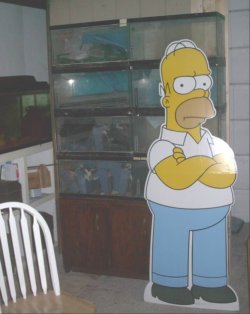Honestly, Aussie, they are a lot of work. It's a labor of love, though,and I really enjoy what I am doing with them.
Since my tanks are in a "fishroom" and not in the house proper where family members would be disapproving of a perceived "dirty tank", I have a little breathing room. I'm not necessarily keeping tanks to be beautiful pieces of furniture to show off in the house, they are more for the fishes benefit. Most of my breeder tanks have brown painted (outside) bottoms with just a thin layer of gravel, sometimes only covering half the bottom of the tank. The fish feel just as comfortable this way (corys especially) and siphoning the bottom of the tank is much easier. Every one of my freshwater tanks has at least floating plants, in addition to helping the fish feel secure and providing cover for baby fish, they help to stabilize water quality. I do water changes at least once a week, more often if I see it is necessary. Algae in the tank (growing on the glass) is not a nuisance but a natural part of the fish's environment. I feed at least twice a day, small amounts, once in the morning before I go to work, once in the evening when I get home from work, occasionally they will get another small meal later in the evening. As I said earlier, most of my fresh tanks are filtered with air pump and box filters or sponge filters. Of course, larger fish such as angels, bumblebees, etc. get power filters. But I try to keep things as simple as I can.
I don't know how much freshwater experience you have. I would definitely recommend that you get some freshwater experience under your belt, you need to be familiar with caring for various types of (comparatively) inexpensive fish before you sink your money into $$$saltwater fish and really get discouraged and into debt all at the same time. If you can remember to be patient when you are starting out with saltwater, let nature take its course because that's really what you are doing is creating a miniature world for these creatures to live in, it's got to be right. Read as much as you can get your hands on, but remember that there are many different ways to set up a saltwater tank, so what you are reading by one author may conflict with what another one recommends. Doesn't mean that anybody is "wrong", it's just like this forum, different things work better for different individuals. All four of my saltwater tanks are set up a little differently. For years I heard that you could not run a saltwater tank without a protein skimmer, but my first three tanks run without one. It wasn't until I set up my 125 that I could see the need for one. This is in part due to the low bio-load i put on my tanks and the combination of live rock/deep sand bed/high current and a power filter on each of those other tanks. There is so much to factor into the equation......I would highly recommend to anyone wanting to get into saltwater, you need to get a copy of Bob Fenner's "The Conscientious Marine Aquarist" and read it from cover to cover....a couple of times. Good basic information here, presented in a "readable" way...if you're at all interested in fish, it will hold your attention.


 love the pictures of all your tanks and fishies! They're great!
love the pictures of all your tanks and fishies! They're great!  You've done really well!
You've done really well!